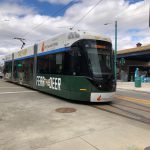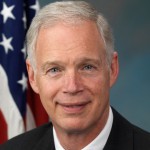LaHood to next governor – “This train will not be stopped”

Transportation Secretary Ray LaHood and Gov. Jim Doyle sign an agreement releasing $46.5 million in high-speed rail funds to Wisconsin. Photo by Patti Wenzel
At an appearance in Watertown yesterday, U.S. Transportation Secretary RayLaHood made it clear that the Milwaukee to Madison high-speed train is a fait accompli.
LaHood was in Watertown for the ceremonial signing of papers releasing $46.5 million of the total $822 million in high-speed rail funds awarded to the state. He was joined by Gov. Jim Doyle, Watertown Mayor Ron Krueger and Madison Mayor Dave Cieslewicz, who expressed gratitude to LaHood and President Obama for making the train a reality in their communities.
LaHood said that high-speed rail is a national initiative, Obama’s vision to connect the major economic centers of the nation by rail, just as President Eisenhower envisioned connecting the nation via the Interstate Highway System.
That was a “vast system of interconnected highways criss-crossing the nation. It has moved products of industry to market, linked affordable homes to quality jobs. But the interstate didn’t start out that way, it started as a bold, daring idea.”
“Obama is working to achieve a vision of similar scope and detail as the Interstate,” LaHood said. “We’re going to transform travel in America with historic investment in interstate rail. Within the next 25 years, 80 percent of America will be connected with high-speed intercity rail, and that is a grand achievement.”
While we know much of the who, what, where and when, reporter questions focused on the “what if?” – as in “What if a Republican takes over Gov. Doyle’s office?” or “What if the legislature changes parties?” or “What if Senator Feingold is defeated?” What will happen to the high-speed train when candidates who have vowed to kill the project take office?
LaHood reiterated that high-speed rail is a national project and that it will withstand changes in governors, legislators and even presidents. He described the rail program as something the citizens of Wisconsin and America want and that this administration is making the investment to create a program that will continue well beyond elections.
“Wisconsin is getting high-speed rail, you can’t stop it.” LaHood added
“It is unthinkable that a governor would come in and stop the thousands of people at work on this. That they would say ‘Okay, take off the hardhats and go home.’ It’s not going to happen. This is happening, people can like it or not, but this is the secretary’s call, not the next governor of Wisconsin.”
Both LaHood and Doyle extolled the economic benefits of the train, the potential to connect Milwaukee and Madison to other industrial, technological and idea centers in the Midwest and nation and the immediate construction jobs of erecting bridges, laying new track and building the trains.
Both also said the worry over the future operating costs for the train is premature and overblown. LaHood said that once the infrastructure is in place and service is running, the federal government will look at assisting states with those costs. It could be in the form of outright aid or in legislative changes that would allow a percentage of capital funds to be used for operations, similar to recent changes made to federal bus transit funds.
Doyle said the current agreement with Amtrak for the Hiawatha trains to Chicago spread the cost between Amtrak, the state and passenger fares.
“The cost of the Milwaukee to Chicago line is only 1 percent of our (state) transportation budget and I don’t see the Milwaukee to Madison line costing more than 1 percent of that budget either.”
While LaHood, Doyle and the other officials were thrilled with the prospect of high-speed rail running through the state, three Watertown businessmen stood in the back of the room and shared their skepticism for the project.
Dan (who asked for his last name to be withheld) would like to see the entire project scrapped, not just in Wisconsin, but across the nation. He said the taxes to support this will put him out of business, bankrupt his grandchildren and turn America into Europe.
“We don’t want to be Europe. Europe is failing and if we do this, America will fail right along with them,” Dan said.
Trevor Price lives on a street that will be closed when the tracks are laid for the project. He thinks the estimates of ridership are overblown and don’t take into account the economic realities that commuters consider. He figured a round trip ticket at $30 from Watertown to Milwaukee five days a week for 50 weeks a year will cost a commuter $7,500 annually. Contrast that with a commuter driving their 25 mpg car 100 miles round trip to Milwaukee the same number of days. Price figured that would cost $2,750 if gas costs $2.75 a gallon.
“It’s just not fiscally responsible,” Price said, adding that businessmen will not want to ride the train and waste hours doing nothing.
LaHood would counter Price’s concerns by reminding him that Milwaukee to Watertown is only a segment in a much larger vision – a vision to connect the nation by rail and create economic corridors that will not be stopped.























I must disagree with the Dan, who dosen’t want his last name published. while I don’t want the United States to become Europe. We fought and won the Revolutionary War of I remember correctly. I sure would like their transportation system. An very efficient integration of rail, bus, auto and pedestrian modes that allows inexpensive and rapid travel all over the continent.
This first step in bringing high speed rail to our state puts us on the track to economic recovery and future prosperity. The travelers on the train will not be doing nothing. They will be working on their laptops, talking and texting with associates, or they just might take a nap. The biggest difference they won’t be driving, while they do these things.
Also Dan, the business man, doesn’t seem to take all the costs into account, which makes me wonder… but anyway. Insurance, wear and tear etc… Triple AAA estimates the cost of owning a car as about $8000 per year. Further he leaves out or unaware that Amtrak sells monthly passes (at a discount) which would bring that price down. For example, I know a bartender who used to ride the Hiawatha to Chicago from Milwaukee regularly for his job, and it worked for him as he had a monthly pass. Finally businessmen and women regularly ride the route between Chicago and Madison, and instead of doing ‘nothing’ they can work (consultants can bill) while riding the train, not easy to do while driving.
The effort by the Obama administration to knit together housing and transportation is a wonderful change. It’s timely because housing costs less when it is near public transportation, as the Center for Neighborhood Technology reports.
In time, the critics of rail will be on board. It is less expensive than maintaining roads and cars, uses less fuel per passenger mile, and is a comfortable way to travel without having ones hands tied to a steering wheel – and safer than a car.
Mr. La Hood is a visionary and his efforts will help American get out of the fossil fuel business into the kind of business that sustains rather than drains our economy.
Economic projections show the train will cost about twice what bus transportation does, requires a far greater capital investment, has less flexibility, and in many cases, will leave passengers miles from their intended destinations. So time savings= zero in most cases. So what is the point?
The most economical thing that can be done is to pull the plug on this thing, up to and including the date it is finally (if at all) finished. Another nail in our economic coffin. YOU think it is a good idea? Invest YOUR money in it.
The operating costs of owning a car is getting extremely expensive, not to mention the ever- increasing costs of road maintenance/design. It is aslo causing great divides in those who can absorb the cost, and those you can’t. If the amount of monies budgeted for this high speed rail line seem exorborant in comparison, you’re right, they certainly are. But, perhaps this also reflects the ‘real’ costs associated with moving masses in a more fuel/energy efficient manner. There’s more facets to this argument than merely counting the dollars spent.
First-name-only Dan has either an active imagination or has been to some of those extremist rallies with the misspelled signs secretly sponsored by Big Oil which is pulling out all the stops to keep oil consumption high in Wisconsin.
Wrong, Mr. LaHood. When Scott Walker is elected, he will kill the choo-choo train. Just another $822 million WE DON’T HAVE!!! Obama will have everyone speaking Chinese in two years because they now OWN OUR NATION!!!
The Federal Railroad Administration (FRA) has just announced it has now received 77 applications from 25 states for the most recent round of High-Speed Intercity Passenger Rail (HSIPR) grant funding, totaling more than $8.5 billion.
This major national rail project has strong bi-partisan support. It will enhance regional mobility, reduce dependence on unpredictable foreign oil, ease highway/airport congestion, and reduce our carbon footprint.
FRA took twenty applications from ten states totaling $7.8 billion for high-speed rail corridor development programs, plus 57 applications from eighteen states totaling $700 million for smaller rail corridors that are ready to begin construction.
Now the FRA will evaluate these applications to identify the projects that will deliver the greatest public benefits and give American taxpayers the highest return on their investment.
$245 million has been reserved for individual projects ready to begin construction. Recipients of this funding will be announced soon.
FRA has already awarded over $583 million to states for HSIPR, including Wisconsin.
LaHood reiterated that high-speed rail is a national project and that it will withstand changes in governors, legislators and even presidents. He described the rail program as something the citizens of Wisconsin and America want and that this administration is making the investment to create a program that will continue well beyond elections.
“Wisconsin is getting high-speed rail, you can’t stop it.” LaHood added
What an arrogant, pompous SOB he is! I think he told us he will ignore the will of the people. He will waste billion of federal tax dollars on a monument to his ignorance. Who the hell does he think he is?
Strong bipartisan support?!
Did you even read the article?
Wisconsin won the national competition to get high-speed rail stimulus money to spur development and link Midwestern cities. Forty states applied, but only Wisconsin got everything
it asked for – over $810 million.
But Scott Walker’s unfortunate campaign strategy is to appeal to emotional knee-jerk voters, and he has singled out the HSR project as a political symbol of what he calls “runaway government spending.”
Some stretches of the current Madison-Milwaukee line are so old that freight trains can only move up to 10 mph. This federal cash will upgrade the line to double track with initial speeds of 79 mph and, by 2016, 110 mph. (California and Florida’s new HSR trains will top 220 mph and 150 mph respectively.)
Scott Walker diminishes the line’s importance. In reality it’s the first leg in a huge network extending to the Twin Cities and Chicago and stations stretching from Kansas City to Cleveland.
Tommy Thompson, the four-term Republican governor, first promoted high-speed rail here in the early 1990s (though in true party-line fashion he now steps aside from those efforts.) Jim Doyle rode on Spain’s new bullet trains and convinced Spanish trainbuilder Talgo to build them in Wisconsin.
Scott Walker tells anyone who will listen that Milwaukeeans can get to Madison cheaper and faster by taking a car than by riding a train. Does Scott Walker just not get it or – more likely – is he talking down to his favorite audience hoping to stir anger he thinks will benefit his campaign?
This is way beyond just Milwaukee-to-Madison – this is the first leg of an intercity project to connect the nation, and more people will use it in a year than will use the Madison and Green Bay airports combined.
The state’s current subsidy for rail is tiny compared to roads, just $1.38 per Wisconsin resident on rail, compared to $360 per person on bridges, highways and roads. And this is a jobs initiative with thousands of state workers on this project, maybe 5,500 jobs at the peak of construction by 2012.
Scott Walker says he “would like” for the state to be able to use the money for other transportation projects, except that would require a change of law by Congress, now committed to this national high-speed rail program.
Wisconsin’s agreement with the federal government says that Wisconsin would have to pay back the $810 million if the state stops high-speed rail service even in the next 20 years – plus Wisconsin would end up paying perhaps $300 million extra to cancel the contracts, all without getting a penny of benefits.
Even if Scott Walker would win and was successful in stopping construction of the line and Wisconsin’s money did return to the federal government (plus an estimated $80 million more for work already done), other more-visionary state governors would want it. In reading about Scott Walker’s campaign shenanigans, 25 of them have just applied to the federal government for help with 77 different projects. Those requests total over $8.5 billion, but with only $2.3 billion available, Wisconsin – as usual, a big “donor state” – again would get to pay for other states’ rail projects.